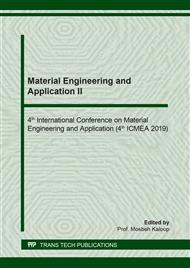[1]
T. Yeoh, Country Guide: Malaysia Personal Care & Cosmetics Products, US Commercial Service Kuala Lumpur. (2016).
Google Scholar
[2]
S. Krishnan, A. N. Safia, A. U. Nur, S. Siti, H. Muhamad, The usage of cosmetic in Malaysia: understanding the major factors that affect users, Manag. 7(1) (2017) 48-51.
Google Scholar
[3]
Zion Market Research, Cosmetic skin care market by product type report. (2018).
Google Scholar
[4]
M. Noorita, B. Rohaizat, Assessment of consumers' religiosity consciousness of Malaysian green personal care products, Inter. J. Eng. Tech. 7 (2018) 646-650.
Google Scholar
[5]
M. A. Nilforoushzadeh, M. A. Amirkhani, P. Zarrintaj, A. S. Moghaddam, T. Mehrabi, S. Alavi, M.M. Sisakht, Skin care and rejuvenation by cosmeceutical facial mask, J. Cos. Derma. 17(5) (2018) 693-702.
DOI: 10.1111/jocd.12730
Google Scholar
[6]
A. Sionkowska, K. Lewandowska, A. Planecka, P. Szarszewska, K. Krasinska, B. Kaczmarek, J. Kozlowska, Biopolymer blends as potential biomaterials and cosmetic materials, Key Eng. Mater. 583 (2014) 95-100.
DOI: 10.4028/www.scientific.net/kem.583.95
Google Scholar
[7]
A. Sirimuangjinda, K. Hemra, D. Atong, C. Pechyen, Comparison on pore development of activated carbon produced from scrap tire by potassium hydroxide and sodium hydroxide for active packaging materials, Key Eng. Mater. 545 (2013) 129-133.
DOI: 10.4028/www.scientific.net/kem.545.129
Google Scholar
[8]
D. Das, D. Samal, B.C. Meikap, Preparation of activated carbon from green coconut shell and its characterization, J. Chem. Eng. Pro. Tech. 6(5) (2015) 248-255.
Google Scholar
[9]
Z. Qian, Coal sampling and Analysis Standards, IEA Clean Coal Center, United Kingdom. (2014).
Google Scholar
[10]
S. Tritti, I. Matthew, S. C. Steven, Fast pyrolysis of coconut biomass-an FTIR study, Fuel. 105 (2013) 559-565.
DOI: 10.1016/j.fuel.2012.09.039
Google Scholar
[11]
American Society for Testing and Materials (ASTM). Standard Test Method for determination of iodine number of activated carbon, ASTM D4607-94. Philadelphia, PA, USA: ASTM Committee on Standards, (2006).
Google Scholar
[12]
R. Elmoubarki, M. Taoufik, A. Moufti, H. Tounsadi, F.Z. Mahjoubi, Y. Bouabo, S. Qourzal, M. Abdennouri, N. Barka, Box-Behnken experimental design for the optimization of methylene blue adsorption onto Aleppo pine cones, J. Mater. Env. Sci. 8(6) (2017) 2184-2191.
DOI: 10.1007/978-3-319-70548-4_55
Google Scholar
[13]
A. U. Itodo, F. W. Abdulrahman, L. G. Hassan, S. A. Maigandi, H. U. Itodo, Application of methylene blue and iodine adsorption in the measurement of specific surface area by four acid and salt treated activated carbon, J. New York Sci. 3(5) (2010) 25-33.
Google Scholar
[14]
V. Hernandez-Montoya, J. Garcia-Servin, J. L. Bueno-Lopez, Thermal treatments an activation procedures used in the preparation of activated carbons, Lignocellulosic Precursors Used in the Synthesis of Activated Carbon. (2010) 19-36.
DOI: 10.5772/39365
Google Scholar
[15]
A. M. Gabriel, Y. Kim, A. Amini, Q. Zhang, T. H. Boyer, Efficiency and life cycle environmental impacts of ion-exchange regeneration using sodium, potassium, chloride, and bicarbonate salts, Chem. Eng. J. 254 (2014) 198-209.
DOI: 10.1016/j.cej.2014.05.086
Google Scholar
[16]
A. Tai, R. Bianchini, J. Jachowicz, Texture analysis of cosmetic/pharmaceutical raw materials and formulations, Int. J. Cosmet. Sci. 36(4) (2014) 291-304.
DOI: 10.1111/ics.12125
Google Scholar
[17]
Hunter Lab, Insight on color, CIE L*a*b* color scale application note 8 (7). Virginia, USA: 2008; 1-4. https://www.hunterlab.se/wp-content/uploads/2012/11/CIE-L-a-b-.pdf.
Google Scholar
[18]
H. J. Kwon, The beauty industry and engineering technologies, Inter. J. Eng. Tech. 7 (2018) 78-81.
Google Scholar


